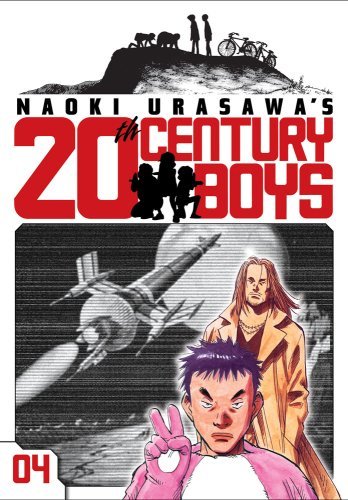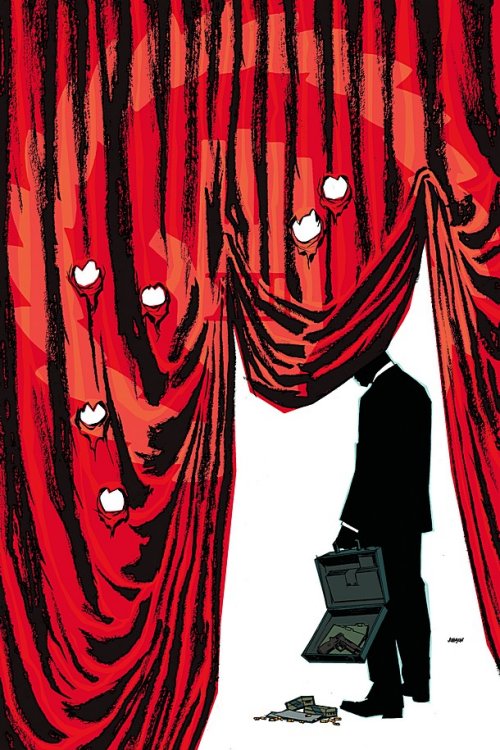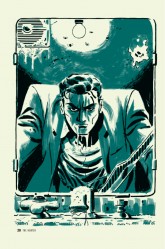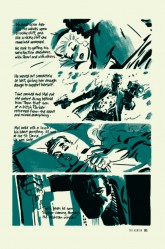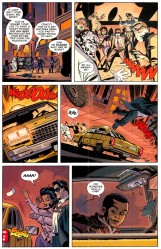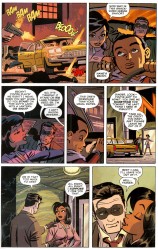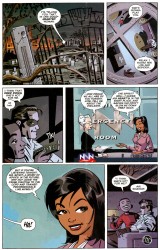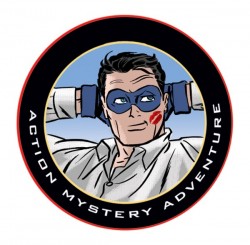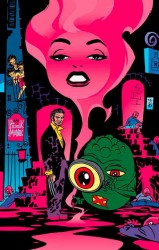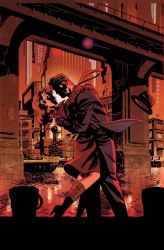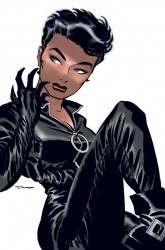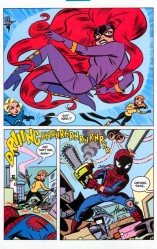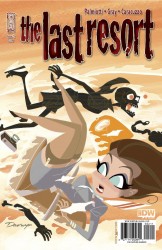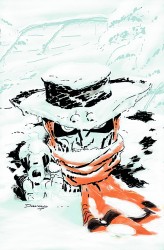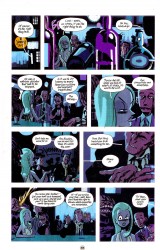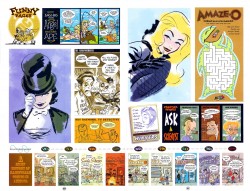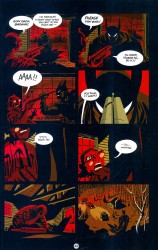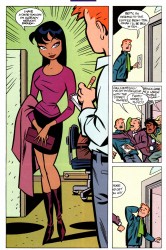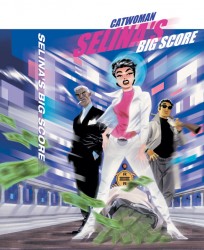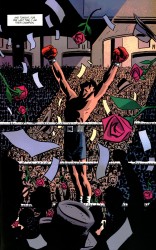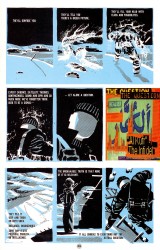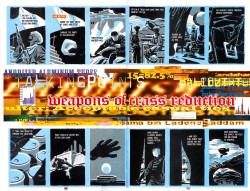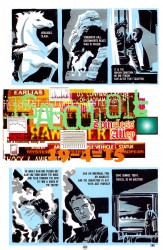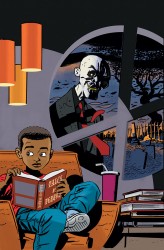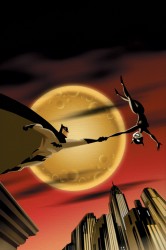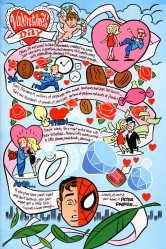A couple weeks ago, I had the bright idea of doing a gift guide. We’d each pick four books (because of the site, you see, and because I am a narcissist) and talk about why you should buy them for friends and family. Except then I got slammed at work, Gav hit Retail Hell (his favorite time of year) and Esther accidentally read an issue of X-Men and fainted dead away on the spot.
So, instead, the 4thletterers (4thletterkateers? citizens of Earth-4thletter?) are presenting to you twelve (or so, none of us are math majors) books that you should definitely, absolutely spend your Christmas money on. And if you do it through Amazon by clicking here… you help us out, too.
Gavin
Essential Super-Villain Team-Up, Vol. 1
The Marvel Essential books are always fun to read, but they are also incredibly intimidating. I can’t get into reading the ones about Captain America, Spider-Man or the X-Men because they have hundreds upon hundreds of comics. It’s more fun to read through a series that had a more finite number of stories. Stuff like Spider-Woman, Iron Fist and Godzilla.
My favorite one, and the one I always suggest to others, is Super-Villain Team-Up. Don’t be fooled by the title. It isn’t about various villains joining together to take over the world and then fail due to the Avengers and/or Fantastic Four. At least, not for the most part. It’s mainly about the strange, but intriguing relationship between Doctor Doom and Namor, two Marvel kings who at times ride the line between hero and villain. Before that, there are several issues of Astonishing Tales that tell the story of Doctor Doom and his would-be usurper Count Rudolfo, a character who never met his full potential.
The dynamic of Doom and Namor lasts for well over a dozen issues, including two specials and an Avengers crossover with special appearance by Dr. Henry Kissinger. Sometimes they help each other out. Sometimes they’re at each other’s necks. But you know what? Not ONCE do they go forth with a collaborative way to take over the world. It’s STILL fun as hell.
There is a satisfying conclusion to their stretched out story arc, leading the way to a weird Doom vs. Magneto storyline and a disappointing Red Skull/Hate-Monger issue. Just consider that one an extra to a great collection.
The Death and Return of Superman Omnibus
I wasn’t reading comics when Death of Superman came out, but I remember how big a deal it was. It did lead to one of my favorite Saturday Night Live skits where Chris Farley as the Hulk represented Marvel Comics and read a eulogy at Superman’s funeral ending with him smashing the podium and mumbling, “’Nuff said.” Plus, despite what people say about the lack of good Superman videogames, I’ve always dug the Death and Return of Superman SNES game.
The SNES game gave me a very skimmed look at the story’s events. When I got into comics for reals in the early 2000s, I had the idea that the whole story was a dull piece of garbage that wasn’t worth my time. After all, the 90s were known for long comic stories that tried to take the classic hero out of the picture, only to fail miserably, such as Knightfall, Clone Saga, Age of Apocalypse, and Onslaught/Heroes Reborn. The only reason I did read Death of Superman in the first place was because I was getting into Booster Gold at the time and wanted to read as many of his appearances as possible.
I dug it! Even knowing who the true Superman was and who Visor Superman and Cyborg Superman would turn out to be didn’t stop me from enjoying the hell out of the epic. Granted, the art does jump around and the Funeral for a Friend part can’t end fast enough, but everything else is fantastic. We get a good mystery, featuring some crafty red herrings and a couple neat hints here and there. Like when Cyborg Superman is in the White House, connecting to all the satellites and computers, there’s a monitor in the background that shows the Fantastic Four symbol. It’s a nice little clue on his original identity.
Even knowing who the real Superman is, you don’t even realize that he’s shown up until several issues after he appears. There’s some nice distraction in the storytelling to trick you.
The omnibus has the entire series in one thick hardcover for your enjoyment, plus extras in the back. It is a lot cheaper and easier to get the softcovers (The Death of Superman , World Without a Superman
, World Without a Superman , The Return of Superman
, The Return of Superman ), but I’m throwing the option out there. With the softcovers, you can easily skip over Funeral for a Friend, but that does mean having to miss out on the “first sighting” segments at the end. That part still gives me chills.
), but I’m throwing the option out there. With the softcovers, you can easily skip over Funeral for a Friend, but that does mean having to miss out on the “first sighting” segments at the end. That part still gives me chills.
The Marvel Art of Marko Djurdjevic
I feel bad for saying this, but I’m not a big art guy. Yes, I appreciate good art, but I don’t go out of my way to collect it. When at Comic Con with hermanos and our good friends at Funnybook Babylon, they’ll usually be scouring Artist Alley as I wander around for other treasures.
That said, I have a jonesing for anything with Marko Djurdjevic’s name on it. I absolutely love his stuff. When I found out there was going to be a book of all his different Marvel covers, I was on it like consonants on “Djurdjevic.” That awesome cover of Dr. Doom holding the Infinity Gauntlet for What If: Secret Wars? It’s in there. Wolverine impaling Blade’s skull? It’s in there. The mind-blowing cover to Daredevil #100?
Hells yes, it’s there.
It features commentary by Djurdjevic for most of the pieces. This includes a bit in the end where he shows some attempts to redesign key characters. Apparently, he wanted to transform Iceman into Terry Bogard from Fatal Fury/King of Fighters. I can dig that if it involves knocking Apocalypse off a rooftop.
Cookin’ with Coolio: 5 Star Meals at a 1 Star Price
David: Gav, I need to talk to you about your pick for the holiday article.
Gavin: Is this about the omnibus? Because I didn’t know it was out of print until I handed it in.
David: No, I—
Gavin: Okay, I admit it! I found out about two sentences in! But they’re still selling it at a ridiculous price! Cut me some slack!
David: Stop. Please.
Gavin: You did say please. What’s up?
David: Cooking with Coolio? Seriously?
Gavin: I know! It’s great, isn’t it? I can’t believe it exists either. Just like that autobiography by Dustin Diamond.
David: That’s not what I’m talking about.
Gavin: It damn well should be! There’s a segment in the book called “Pimp Your Shrimp”!
David: Gav? Can you tell me something?
Gavin: I can tell you many things. I can tell you how to both chill and grill at the same time thanks to this amazing book.
David: No, I want you to tell me something specific.
Gavin: Oh, right. It’s on page—
David: Not that! I want to know what Coolio has to do with comics. This is a comic book site. You realize that?
Gavin: But he’s comic…al?
David: …….
Gavin: He is! You should read the back cover! It describes him as being “one of the most popular and successful rappers worldwide”!
David: I don’t care.
Gavin: He had a couple hits well over a decade ago and they still have the balls to say that! He’s most famous for being completely butthurt at Weird Al because the theme to that Michelle Pfeiffer movie is serious business! You ever see him on that Celebrity Poker Showdown show? He was out in two hands because he kept betting all-in!
David: That still has nothing to do with comic books.
Gavin: He… was in Batman and Robin. Oh, and he was in the director’s cut of Daredevil!
David: *sigh* Fine. Do whatever. I don’t have time for this.
Gavin: Of course. Busy with Kwanzaa and all that.
David: …
Gavin: What?
Esther
Blue Beetle
I’ve recommended these before, but I’m just going to keep on doing it until everyone has them. This is an all-ages comic in the best sense of the word. A grandfather could read these and love them. A small child could read them and love them just as much.
Jaime Reyes has somehow managed to become attached to The Scarab. It’s a ancient alien artifact that becomes sentient and gives him fantastic powers. Soon there are superheroes on his doorstep and aliens invading earth. Helping Jaime deal with this is his close-knit family and his two friends, Paco and Brenda.
It sounds like every superhero’s story. It isn’t. I don’t know how to describe it, except to say that the heart that goes into this story makes it stand out from every single book on the shelf. This is a story that will shock you with its power and its intrinsic sweetness. Buy it. Buy it. My god, buy it.
The volumes are, in order: Shellshocked , Road Trip
, Road Trip , Reach for the Stars
, Reach for the Stars , and Endgame
, and Endgame .
.
Two Superman Books with Tim Sale Art: Superman for All Seasons , and Superman: Kryptonite
, and Superman: Kryptonite
There are few books that I read for the art. I’m a story and character junkie. Tim Sale’s Superman, though, gets me every time. The enormous, meaty face, the dark eyes, the way the character never seems to know what to do with his hands, they all add up to a story that you don’t need be able to read to understand.
Superman for all Seasons and Kryptonite, though, are worth getting out your reading glasses, though. They have the same thing that attracted me to the Blue Beetle series; an optimistic sweetness. That tone is hard to find anywhere. It’s too easy to prop up a story with horrors, or go for the cheap sensationalism of a hero pushed to the edge. Good books that are about the struggle to be kind, to be generous, to do the right thing, are worth a lot more than another edgy comic.
Agent X
So let’s talk about cheap sensationalism and a hero pushed to the edge. Agent X is an early Gail Simone book. Published by Marvel, it’s about a scarred anti-hero with no memory who careens through the Marvel Universe in the least dignified way possible. The hero, Alex Hayden, gets trained as a mercenary, goes through a series of disastrous missions, and finally finds his identity and his purpose in life.
Or maybe he doesn’t. It was too funny for me to really notice. A well-drawn, well-paced and hilariously funny series that was (criminally), never collected, this is worth haunting eBay for.
David
Kiyohiko Azuma’s Yotsuba&!
You know what’s really, really nice? Having a book you know without a doubt that you can turn to have your mood lighten. Yotsuba&! is like that. The story of Yotsuba and her group of friends and family is a great one, made even better by its simplicity. There’s no overarching plot beyond “Yotsuba and…,” though there is continuity between the stories.
One of the best parts is Yotsuba’s relationships. Her relationship with the world is one of utter naiveté and sheer joy. Everything she sees is a source of wonder and possible fun. Her relationship with her friends, the three girls who live next door, varies according to their ages in a really interesting way. Her relationship with her dad is part brother and sister and part sidekick, with lots of shouting and posing and >:O faces. Her relationship with her dad’s two friends, Yanda and Jumbo, is hilarious and completely believable.
Yotsuba is young, energetic, credulous on a level that is equal to six Amelia Bedelias, and intensely curious. The series is fun, and you can pick up any of the seven volumes that are currently out without missing anything major. And good on Yen Press for picking up the lapsed rights to it.
without missing anything major. And good on Yen Press for picking up the lapsed rights to it.
Yotsuba&! is cake comics, intensely enjoyable from all angles. Savor it when you read it.
Richard Stark’s Parker: The Hunter (Darwyn Cooke)
Sometimes, not all of the time, but sometimes, you just need to see somebody get what’s coming to them. And Parker: The Hunter delivers that in spades. Parker is a cold blooded man in the truest sense of the word. Though driven by revenge, he’s scarily calm and collected throughout the book. He doesn’t pause at doing things that would slow a normal person down and when he tracks down his target, there’s no explosive confrontation. It’s a foregone conclusion.
Darwyn Cooke’s already impressive art hits a new level here, with a clean green being the only color in the work, barring the color of the paper and strong blacks. It’s a treat to look at, even without reading the words. It feels like a crime comic should, with a palette that puts you out of your comfort zone and a main character that’s about as bad as the bad guys.
This book is the kind of thing that’s aimed directly at me, crime movie junkies, and people who like a layer of grime on their books. Almost as good as the book itself is its design, which is decidedly not that of your average comic. It looks like a crime novel, or a particularly fancy DVD cover, and the image instantly sets the tone. Totally one of my favorites this year, if not the favorite.
Pluto: Urasawa x Tezuka, Vol. 1
I could spend another eighty thousand words talking about this wonderful book, and The Hunter‘s only real competition this year, or I could point you here, here, and here. Buy it now and you can say you liked it before it wins every award at the Eisners next year.
And if it doesn’t win anything… we’re bumrushing the stage.
Takehiko Inoue’s Vagabond
A financial reason you should buy Vagabond Vizbig Volume 1: It has six hundred pages for twenty bucks, half that if it’s on sale. The value is insane.
A story-based reason you should buy Vagabond Vizbig Volume 1: It tells the story of Miyamoto Musashi, the most popular samurai ever, and how he came to be. We learn about his past, his friends, his family, and his love. We see him when he is talented, but not skilled, and little more than a savage. We see him fall back into old habits over and over while striving to be the best.
An art-based reason you should buy Vagabond Vizbig Volume 1: It looks amazing. Inoue employs a variety of styles throughout the book, resulting in a tale where the art adds a whole lot to the text, above and beyond the call of duty. Facial expressions, posture, and eyes tell tales above and beyond what the word balloons do. Visual metaphor is used to great effect, being both instantly recognizable (though one metaphor in book 4 was intended to take its time, and it paid off huge) and beautiful.
A historical reason you should buy Vagabond Vizbig Volume 1: It’s a manga based on novel based on the life of a real person. It may not be 100% historically accurate, but it is primarily rooted in fact. There are no magic powers, nothing outlandish. It’s just the story of a man, his sword, and his thirst to be the best. You learn something along the way about Japanese history, culture, and various forms of martial arts. You learn the advantages a spear has over a sword, and a sword over a spear. When you finish a volume of Vagabond, you come away with something more than you came in with.
One last reason you should buy Vagabond Vizbig Volume 1: It’s insanely good, bottom line. Words, story, setting, all of it is dead on.

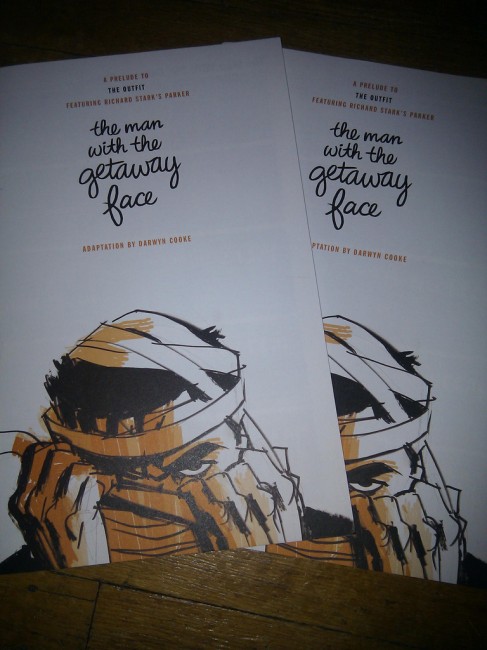
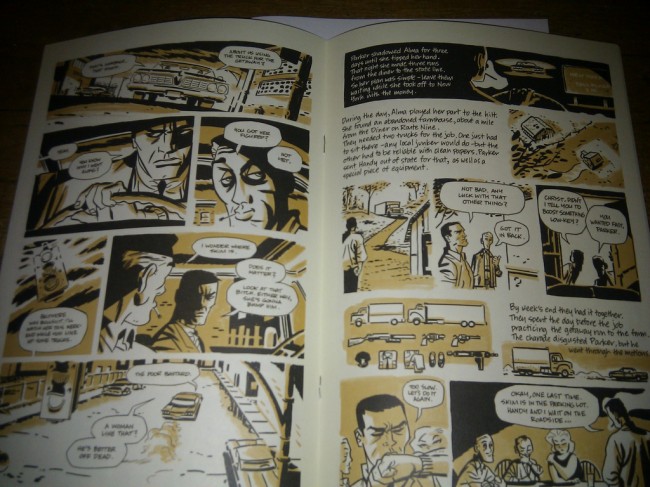
.

